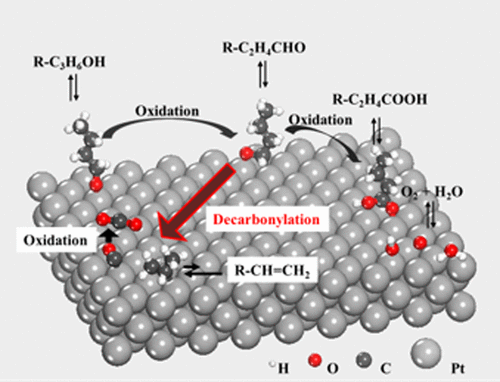当前位置:
X-MOL 学术
›
ACS Catal.
›
论文详情
Our official English website, www.x-mol.net, welcomes your feedback! (Note: you will need to create a separate account there.)
Deactivation of Supported Pt Catalysts during Alcohol Oxidation Elucidated by Spectroscopic and Kinetic Analyses
ACS Catalysis ( IF 12.9 ) Pub Date : 2017-09-06 00:00:00 , DOI: 10.1021/acscatal.7b02201 Jiahan Xie 1 , Pu Duan 2 , Nicholas Kaylor 1 , Kehua Yin 1 , Benjamin Huang 1 , Klaus Schmidt-Rohr 2 , Robert J. Davis 1
ACS Catalysis ( IF 12.9 ) Pub Date : 2017-09-06 00:00:00 , DOI: 10.1021/acscatal.7b02201 Jiahan Xie 1 , Pu Duan 2 , Nicholas Kaylor 1 , Kehua Yin 1 , Benjamin Huang 1 , Klaus Schmidt-Rohr 2 , Robert J. Davis 1
Affiliation

|
The selective oxidation of 1,6-hexanediol with O2 to product aldehydes and acids occurs readily in water over supported Pt nanoparticles. The initial turnover frequency of 0.54 s–1 (at 343 K and 1 MPa O2) decreases significantly with reaction time because of product competitive adsorption and irreversible adsorption of unknown strongly bonded species. To identify the poisoning species, in situ surface-enhanced Raman spectroscopy (SERS) and solid-state 13C nuclear magnetic resonance (NMR) spectroscopy were applied in this work. In situ SERS during 1,6-hexanediol oxidation revealed an accumulation of di-σ-bonded olefinic species with features at ∼1150 and ∼1460 cm–1 on the poisoned Pt surface. Consistent with SERS, 13C NMR spectroscopy of a Pt catalyst deactivated by oxidation of 13C-labeled 1,4-butanediol revealed a C═C peak associated with ethylene. Molecules containing olefinic groups are 2 orders of magnitude more effective at competing for Pt surface sites in comparison to the aldehyde and acid products from alcohol oxidation. The poisoning olefinic species were generated by decarbonylation of product aldehyde (as revealed by head space analysis) and could be easily removed from the deactivated catalyst by mild treatment in H2.
中文翻译:

光谱和动力学分析表明,醇氧化过程中负载的Pt催化剂失活
在水中在负载的Pt纳米颗粒上很容易发生O 2与1,6-己二醇选择性氧化生成醛和酸的现象。初始转换频率0.54 s –1(在343 K和1 MPa O 2下)随着反应时间的增加而显着降低,这是由于产物竞争性吸附和未知强键合物种的不可逆吸附。为了确定中毒种类,在这项工作中应用了原位表面增强拉曼光谱(SERS)和固态13 C核磁共振(NMR)光谱。在1,6-己二醇氧化过程中的原位SERS揭示了双σ键合烯烃的堆积,其特征在〜1150和〜1460 cm –1处在中毒的铂表面上。与SERS一致,通过13 C标记的1,4-丁二醇氧化而失活的Pt催化剂的13 C NMR光谱显示与乙烯相关的C═C峰。与醇氧化产生的醛和酸产物相比,含烯烃基团的分子在竞争Pt表面位点时要有效2个数量级。中毒的烯类物质是通过产物醛的脱羰作用生成的(如顶部空间分析所示),并且可以通过在H 2中进行温和处理而轻松地从失活的催化剂中除去。
更新日期:2017-09-07
中文翻译:

光谱和动力学分析表明,醇氧化过程中负载的Pt催化剂失活
在水中在负载的Pt纳米颗粒上很容易发生O 2与1,6-己二醇选择性氧化生成醛和酸的现象。初始转换频率0.54 s –1(在343 K和1 MPa O 2下)随着反应时间的增加而显着降低,这是由于产物竞争性吸附和未知强键合物种的不可逆吸附。为了确定中毒种类,在这项工作中应用了原位表面增强拉曼光谱(SERS)和固态13 C核磁共振(NMR)光谱。在1,6-己二醇氧化过程中的原位SERS揭示了双σ键合烯烃的堆积,其特征在〜1150和〜1460 cm –1处在中毒的铂表面上。与SERS一致,通过13 C标记的1,4-丁二醇氧化而失活的Pt催化剂的13 C NMR光谱显示与乙烯相关的C═C峰。与醇氧化产生的醛和酸产物相比,含烯烃基团的分子在竞争Pt表面位点时要有效2个数量级。中毒的烯类物质是通过产物醛的脱羰作用生成的(如顶部空间分析所示),并且可以通过在H 2中进行温和处理而轻松地从失活的催化剂中除去。


























 京公网安备 11010802027423号
京公网安备 11010802027423号